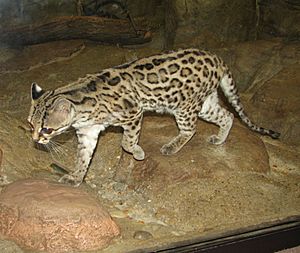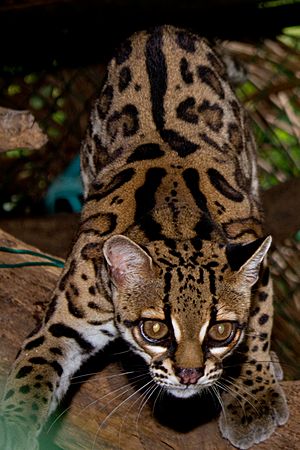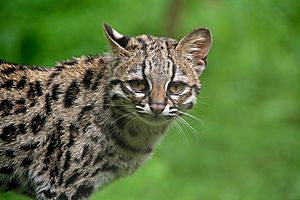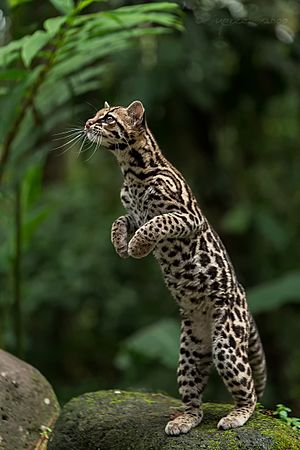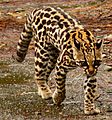Margay facts for kids
Quick facts for kids Margay |
|
|---|---|
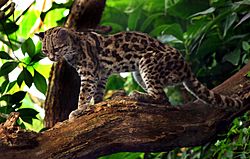 |
|
| Conservation status | |
| Scientific classification | |
| Kingdom: | |
| Phylum: | |
| Class: | |
| Order: | |
| Family: | |
| Genus: | |
| Species: |
L. wiedii
|
| Binomial name | |
| Leopardus wiedii (Schinz, 1821)
|
|
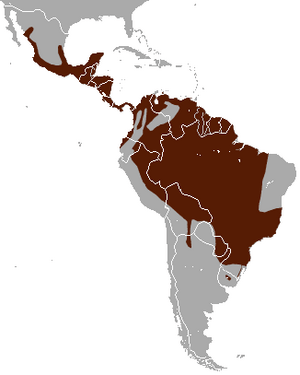 |
|
| Margay range | |
| Synonyms | |
|
|
The margay (Leopardus wiedii) is a small wild cat. It lives in the forests of Central and South America. This cat is nocturnal, meaning it is active at night. It is also solitary, which means it likes to be alone. Margays mostly live in thick evergreen and deciduous forests.
In the past, margays were hunted a lot for their fur. This caused their numbers to drop. Since 2008, the margay has been listed as "Near Threatened" on the IUCN Red List. This means their population is still going down. The main reason for this decline is that their forest homes are disappearing due to deforestation.
Contents
What Does a Margay Look Like?
The margay looks a lot like its bigger cousin, the ocelot. However, the margay has a shorter head and bigger eyes. Its tail and legs are also longer than an ocelot's. A margay usually weighs between 2.6 and 4 kilograms (5.7 to 8.8 pounds). Its body can be 48 to 79 centimeters (19 to 31 inches) long. Its tail adds another 33 to 51 centimeters (13 to 20 inches).
A margay's fur is brown. It has many dark brown or black spots that look like rosettes. It also has long streaks. The fur on its belly is lighter, from a light yellow-brown to white. Its tail has dark bands and a black tip. The backs of its ears are black with a white spot in the middle.
Margays are amazing climbers. They are sometimes called "tree ocelots" because of this skill. A margay might spend its whole life in the trees. It can leap and chase birds and monkeys through the branches.
Margay Behavior
Margays are mostly nocturnal, so they are active at night. Like most cats, they prefer to be alone. They have large home areas, usually about 11 to 16 square kilometers (4.2 to 6.2 square miles). They mark their territory using scent, like urine spraying. They also leave scratch marks on the ground or on branches. Margays do not make loud calls to each other over long distances.
The margay is one of only two cat species that can climb head-first down trees. This is because their ankles are very flexible. The other cat that can do this is the clouded leopard. The marbled cat might also have this special ability.
Margays are very agile. Their ankles can turn up to 180 degrees. They can hold onto branches with both their front and back paws. They can also jump up to 3.7 meters (12 feet) sideways. A margay has even been seen hanging from branches with only one foot. They can also run upside down beneath branches!
Where Do Margays Live?
Margays are found from southern Mexico through Central America. They also live in northern South America, east of the Andes mountains. Their range goes as far south as Uruguay and northern Argentina. They almost always live in areas with thick forests. These can be tropical evergreen forests, tropical dry forests, or high cloud forests. Sometimes, margays have also been seen in coffee and cocoa plantations.
Fossils of margays have been found in Florida and Georgia. These fossils are from the Pleistocene era, which suggests they used to live in more places. The last time a margay was recorded in Texas was in 1852.
What Do Margays Eat?
Margays eat small mammals, including monkeys. They also eat birds, eggs, lizards, and tree frogs. The margay can hunt all its prey while staying in the trees. However, they sometimes hunt on the ground too. They have been seen eating cane rats and guinea pigs. During the day, margays rest safely in branches or in clumps of liana vines. There is even a report of a margay using sound mimicry to attract its prey.
Margay Life Cycle and Reproduction
A female margay is pregnant for about 80 days. She usually gives birth to one kitten, but sometimes two. Kittens are usually born between March and June. Newborn kittens weigh about 85 to 170 grams (3 to 6 ounces). This is quite large for a small cat. Their eyes open when they are about two weeks old. They start eating solid food at seven to eight weeks. Margays become adults when they are 12 to 18 months old. In zoos, they have been known to live for more than 20 years.
For example, a 26-year-old margay named Carlota lived at the Cincinnati Zoo and Botanical Garden in April 2018.
Sadly, about half of all margay kittens do not survive. Also, it is hard for them to have babies in zoos. This makes it very difficult to help their population grow.
Conservation Efforts
There are ten different types of margay, called subspecies. They live across a large area from Mexico to Argentina. In the past, they even lived in the southern United States.
Margays were hunted a lot for their fur. This caused their population to drop. About 14,000 margays were killed each year. They also lose their habitat as forests are cut down. This loss of home is a big reason for their decline.
Images for kids
-
Margay in Cincinnati Zoo, United States
See also
 In Spanish: Margay para niños
In Spanish: Margay para niños



